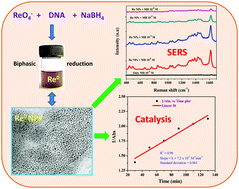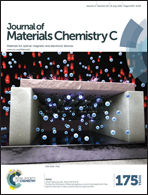A highly stable rhenium organosol on a DNA scaffold for catalytic and SERS applications†
Abstract
Highly stable Re nanoparticles (NPs) have been synthesized in an organic solvent for the first time through a homogeneous reduction route using DNA as a scaffold within 10 min at room temperature. Transfer of both (NH4)ReO4 and DNA salts to the organic layer has been executed by a two phase extraction procedure using TOAB (phase transfer catalyst) followed by successive reduction with NaBH4 resulting in the formation of highly stable Re NPs. By changing the molar ratio of the starting reagents and by varying other reaction parameters, the diameter of the synthesized Re NPs can be tuned. The average diameter of the Re NPs is found to be 1.5 ± 0.7 nm and 6.5 ± 1.5 nm for two different morphologies. The as-synthesized Re organosol has been applied in two distinct potential applications such as catalysis and SERS studies. The catalysis reaction has been done for the reduction of hexavalent chromium ions in the presence of thiosulfate for which the catalytic rate was found to be faster compared to previous reports. SERS activity was monitored using methylene blue (MB) dye as a model SERS probe and the observed enhancement factor (EF) value was 3.35 × 106 using Re NPs having an average diameter of 1.5 ± 0.7 nm. This is the highest EF value for Re organosol ever reported. The synthesized Re organosol has been found to be extremely stable for more than six months when kept in a refrigerator in a sealed container. Moreover, the synthesized Re0 NPs can readily be re-dispersed in all protic and non-protic solvents which can be used for further applications in other interdisciplinary areas.


 Please wait while we load your content...
Please wait while we load your content...